Top Rankings
Fairfield-Suisun Unified School District ranks among the top 20% of public school district in California for:
Category
Attribute
Diversity
Most diverse schools (Top 1%)
Community Size
Largest student body (number of students) (Top 1%)
For the 2025 school year, there are 6 public high schools serving 6,587 students in Fairfield-Suisun Unified School District. This district's average high testing ranking is 7/10, which is in the top 50% of public high schools in California.
Public High Schools in Fairfield-Suisun Unified School District have an average math proficiency score of 27% (versus the California public high school average of 28%), and reading proficiency score of 51% (versus the 51% statewide average).
Public High School in Fairfield-Suisun Unified School District have a Graduation Rate of 89%, which is more than the California average of 87%.
The school with highest graduation rate is Angelo Rodriguez High School, with 96% graduation rate. Read more about public school graduation rate statistics in California or national school graduation rate statistics.
Minority enrollment is 87% of the student body (majority Hispanic), which is more than the California public high school average of 79% (majority Hispanic).
Overview
This School District
This State (CA)
# Schools
31 Schools
2,817 Schools
# Students
20,365 Students
2,139,525 Students
# Teachers
858 Teachers
100,737 Teachers
Student : Teacher Ratio
24:1
24:1
District Rank
Fairfield-Suisun Unified School District, which is ranked #1032 of all 1,925 school districts in California (based off of combined math and reading proficiency testing data) for the 2021-2022 school year.
The school district's graduation rate of 89% has increased from 80% over five school years.
Overall District Rank
#1001 out of 1941 school districts
(Bottom 50%)
(Bottom 50%)
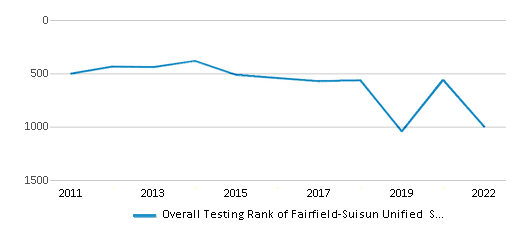
Math Test Scores (% Proficient)
27%
33%
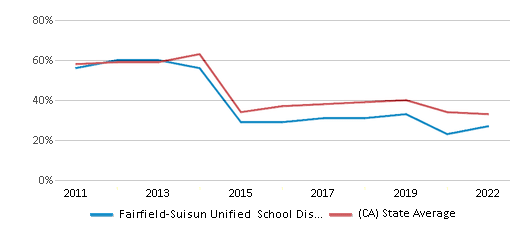
Reading/Language Arts Test Scores (% Proficient)
40%
47%
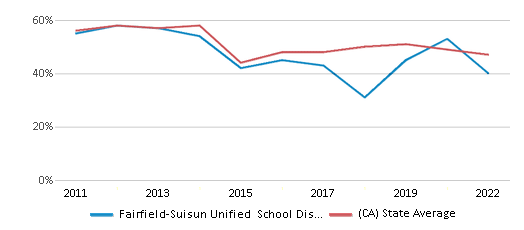
Science Test Scores (% Proficient)
23%
29%
Graduation Rate
89%
87%

Students by Ethnicity:
Diversity Score
0.72
0.63
# American Indian Students
52 Students
10,468 Students
% American Indian Students
n/a
1%
# Asian Students
3,209 Students
244,247 Students
% Asian Students
16%
11%
# Hispanic Students
9,523 Students
1,190,384 Students
% Hispanic Students
47%
56%
# Black Students
2,622 Students
110,575 Students
% Black Students
13%
5%
# White Students
2,633 Students
458,887 Students
% White Students
13%
22%
# Hawaiian Students
213 Students
9,060 Students
% Hawaiian Students
1%
n/a
# Two or more races Students
2,087 Students
108,483 Students
% of Two or more races Students
10%
5%
Students by Grade:
# Students in PK Grade:
-
18
# Students in K Grade:
1,789
25,126
# Students in 1st Grade:
1,499
19,346
# Students in 2nd Grade:
1,568
19,826
# Students in 3rd Grade:
1,582
19,554
# Students in 4th Grade:
1,530
19,798
# Students in 5th Grade:
1,565
20,237
# Students in 6th Grade:
1,540
29,089
# Students in 7th Grade:
1,593
39,371
# Students in 8th Grade:
1,592
41,955
# Students in 9th Grade:
1,458
466,491
# Students in 10th Grade:
1,562
476,582
# Students in 11th Grade:
1,579
469,509
# Students in 12th Grade:
1,508
492,623
# Ungraded Students:
-
-
District Revenue and Spending
The revenue/student of $15,046 in this school district is less than the state median of $19,974. The school district revenue/student has stayed relatively flat over four school years.
The school district's spending/student of $14,277 is less than the state median of $18,396. The school district spending/student has stayed relatively flat over four school years.
Total Revenue
$306 MM
$116,387 MM
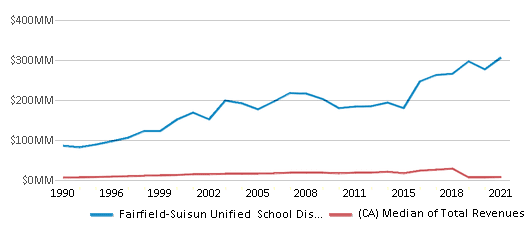
Spending
$291 MM
$107,188 MM
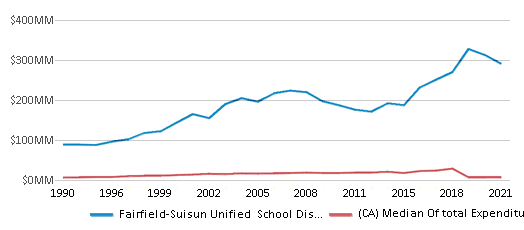
Revenue / Student
$15,046
$19,974
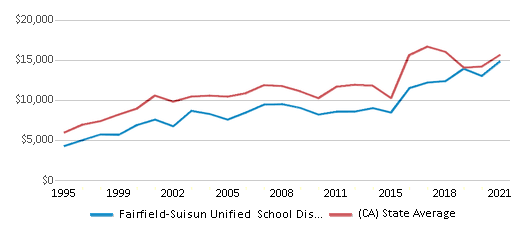
Spending / Student
$14,277
$18,396
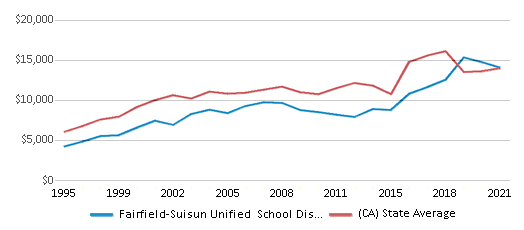
Best Fairfield-Suisun Unified School District Public High Schools (2025)
School
(Math and Reading Proficiency)
(Math and Reading Proficiency)
Location
Grades
Students
Rank: #11.
Public Safety Academy
Alternative School
(Math: 57% | Reading: 78%)
Rank:
Rank:
10/
Top 10%10
230 Atlantic Ave.
Fairfield, CA 94533
(707) 421-3933
Fairfield, CA 94533
(707) 421-3933
Grades: 5-12
| 739 students
Rank: #22.
H. Glenn Richardson
Special Education School
(Math: <50% | Reading: <50%)
Rank:
Rank:
8/
Top 30%10
1069 Meadowlark Dr.
Fairfield, CA 94533
(707) 420-2300
Fairfield, CA 94533
(707) 420-2300
Grades: K-12
| 26 students
Rank: #33.
Angelo Rodriguez High School
(Math: 32% | Reading: 66%)
Rank:
Rank:
8/
Top 30%10
5000 Red Top Rd.
Fairfield, CA 94534
(707) 863-7950
Fairfield, CA 94534
(707) 863-7950
Grades: 9-12
| 2,053 students
Rank: #44.
Armijo High School
(Math: 13% | Reading: 33%)
Rank:
Rank:
3/
Bottom 50%10
824 Washington St.
Fairfield, CA 94533
(707) 422-7500
Fairfield, CA 94533
(707) 422-7500
Grades: 9-12
| 1,899 students
Rank: #55.
Fairfield High School
(Math: 5% | Reading: 29%)
Rank:
Rank:
2/
Bottom 50%10
205 East Atlantic Ave.
Fairfield, CA 94533
(707) 438-3000
Fairfield, CA 94533
(707) 438-3000
Grades: 9-12
| 1,560 students
Rank: #66.
Sem Yeto Continuation High School
Alternative School
(Math: ≤5% | Reading: 10-14%)
Rank:
Rank:
1/
Bottom 50%10
205 East Atlantic Ave.
Fairfield, CA 94533
(707) 438-3170
Fairfield, CA 94533
(707) 438-3170
Grades: 10-12
| 310 students
Recent Articles

Sexual Harassment at Age 6: The Tale of a First Grade Suspension
A six-year old in Aurora, Colorado, was suspended after singing an LMFAO song to a little girl in his class and reportedly “shaking his booty.” We look at the case and the sexual harassment problem in public schools today.

How Scaffolding Could Change the Way Your Child Learns
This article explores the concept of instructional scaffolding, a teaching method that enhances learning by breaking down complex tasks into manageable parts. It highlights how scaffolding supports students in developing critical thinking skills and becoming more independent learners. The article discusses the benefits of scaffolding, including improved engagement and reduced anxiety, and provides strategies for its implementation across various educational levels.

February 05, 2025
Understanding the U.S. Department of Education: Structure, Impact, and EvolutionWe explore how the Department of Education shapes American education, from its cabinet-level leadership to its impact on millions of students, written for general audiences seeking clarity on this vital institution.





